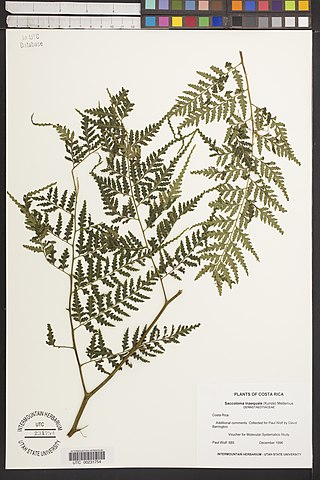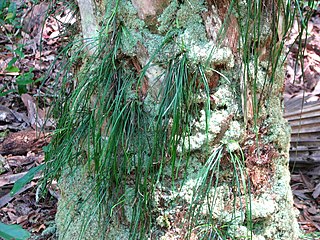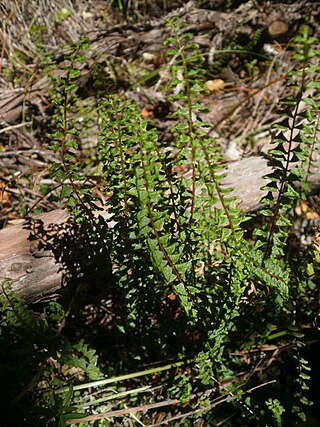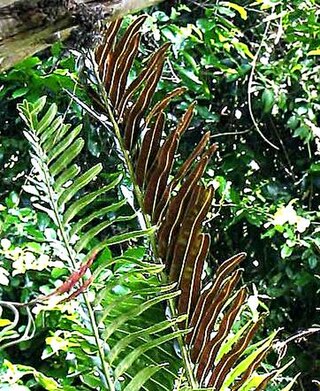
Thelypteridaceae is a family of about 900 species of ferns in the order Polypodiales. In the Pteridophyte Phylogeny Group classification of 2016, it is placed in the suborder Aspleniineae. Alternatively, the family may be submerged in a very broadly defined family Aspleniaceae as the subfamily Thelypteridoideae.

Schizaeales is an order of ferns.

Marattiaceae is the only family of extant (living) ferns in the order Marattiales. In the Pteridophyte Phylogeny Group classification of 2016, Marattiales is the only order in the subclass Marattiidae. The family has six genera and about 110 species. Many are different in appearance from other ferns, having large fronds and fleshy rootstocks.

Pteridaceae is a family of ferns in the order Polypodiales, including some 1150 known species in ca 45 genera, divided over five subfamilies. The family includes four groups of genera that are sometimes recognized as separate families: the adiantoid, cheilanthoid, pteridoid, and hemionitidoid ferns. Relationships among these groups remain unclear, and although some recent genetic analyses of the Pteridales suggest that neither the family Pteridaceae nor the major groups within it are all monophyletic, as yet these analyses are insufficiently comprehensive and robust to provide good support for a revision of the order at the family level.

Saccoloma is a fern genus in family Saccolomataceae. It is the only genus in the family in the Pteridophyte Phylogeny Group classification of 2016, but further investigation is needed. It is pantropical and its species are found in wet, shaded forest areas. Saccoloma species are characterized by an omega-shaped (Ω) vascular bundle in the cross-sections of their petioles. The common name soralpouch fern is used for Saccoloma.

Vittaria, the shoestring ferns, is a genus of ferns in the Vittarioideae subfamily of the family Pteridaceae. It had previously been placed in the family Vittariaceae, but that family is no longer recognized.

Lindsaeaceae is a pantropical family of ferns in the order Polypodiales. It contains six or seven genera with about 220 known species, some of which also extend into the more temperate regions of eastern Asia, New Zealand, and South America.

Saccolomataceae is a family of ferns in the order Polypodiales with about 19 species. It has been formerly treated as part of the Dennstaedtiaceae, however it has been classified as its own family according to Smith et al. (2006) The genus Saccoloma has been classified to include Orthiopteris, but the phylogeny of the group not yet fully understood. The family includes a dozen known species.

Cryptogramma is a genus of ferns known commonly as rockbrakes or parsley ferns. They are one of the three genera in the Cryptogrammoideae subfamily of the Pteridaceae. Cryptogramma ferns can be found in temperate regions on several continents worldwide. These ferns have two kinds of leaves which often look so different that at first glance they appear to belong to different plants. The fertile leaves have long, narrow, bumpy segments with undersides covered thickly in sporangia. The edges of the segments may curl back to cover the sporangia, forming a false indusium. The sterile leaves have thinner, wider segments which may be rounded and resemble the leaves of parsley. These ferns grow in rocky areas, often in crevices and cracks.

Antrophyum is a genus of ferns in the family Pteridaceae. They are commonly known as lineleaf ferns.

Cystopteridaceae is a family of ferns in the order Polypodiales. In the Pteridophyte Phylogeny Group classification of 2016 (PPG I), the family is placed in the suborder Aspleniineae of the order Polypodiales, and includes three genera. Alternatively, it may be treated as the subfamily Cystopteridoideae of a very broadly defined family Aspleniaceae.

Jamesonia is a genus of ferns in the subfamily Pteridoideae of the family Pteridaceae. It now includes the formerly separate genus Eriosorus.

Acrostichum is a fern genus in the Parkerioideae subfamily of the Pteridaceae. It was one of the original pteridophyte genera delineated by Linnaeus. It was originally drawn very broadly, including all ferns that had sori apparently "acrostichoid", or distributed in a uniform mass across the back of the frond, rather than organized in discrete sori. This led Linnaeus to include such species as Asplenium platyneuron in the genus, because the specimen he received had sori so crowded that it appeared acrostichoid.

Vittarioideae is a subfamily of the fern family Pteridaceae, in the order Polypodiales. The subfamily includes the previous families Adiantaceae and Vittariaceae.

Cheilanthoideae is one of the five subfamilies of the fern family Pteridaceae. The subfamily is thought to be monophyletic, but some of the genera into which it has been divided are not, and the taxonomic status of many of its genera and species remains uncertain, with radically different approaches in use as of December 2019.
Haplopteris is a genus of vittarioid ferns, a member of subfamily Vittarioideae and family Pteridaceae.

Onychium is a genus of ferns in the subfamily Pteridoideae of the family Pteridaceae.
Tryonia is a genus of ferns in the subfamily Pteridoideae of the family Pteridaceae. Species are native to the east of Brazil and to Uruguay.
Polytaenium is a genus of ferns in the subfamily Vittarioideae of the family Pteridaceae. Species are native to Mexico and Southern America.
Radiovittaria is a genus of ferns in the subfamily Vittarioideae of the family Pteridaceae. Species are native to southeast Mexico and northern Southern America.
















